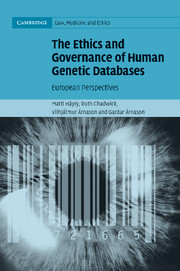Book contents
- Frontmatter
- Contents
- List of contributors
- 1 Introduction: some lessons of ELSAGEN
- Part I Background
- Part II Social concerns
- 5 A sociological perspective: public perceptions of privacy and their trust in institutions managing and regulating genetic databases
- 6 Estonia
- 7 Iceland
- 8 Sweden
- 9 United Kingdom
- 10 Public discourses on human genetic databases
- Part III Legal issues
- Part IV Ethical questions
- Part V Political considerations
- Part VI Conclusion
- Bibliography
- Index
8 - Sweden
from Part II - Social concerns
Published online by Cambridge University Press: 05 August 2012
- Frontmatter
- Contents
- List of contributors
- 1 Introduction: some lessons of ELSAGEN
- Part I Background
- Part II Social concerns
- 5 A sociological perspective: public perceptions of privacy and their trust in institutions managing and regulating genetic databases
- 6 Estonia
- 7 Iceland
- 8 Sweden
- 9 United Kingdom
- 10 Public discourses on human genetic databases
- Part III Legal issues
- Part IV Ethical questions
- Part V Political considerations
- Part VI Conclusion
- Bibliography
- Index
Summary
Introduction
The dramatic developments within biogenetic research during the last decade, and in particular the scientific breakthrough that resulted in the successful mapping of the human genome, as well as the assumed profitability potential in commercial applications of genetic science, have vastly increased the interest in and importance of human genetic databases or biobanks, as they are officially designated in Sweden.
Sweden has a long history of collecting and banking tissue samples for medical purposes, the oldest preserved human biological matter being collected in the later part of the nineteenth century. There are an estimated 80 million samples in Swedish biobanks, collected from the 1940s onward, kept in different ways and consisting of a whole range of various biological matter. The most systematically built biobank is the PKU register, consisting of samples taken from every newborn baby since 1975. The samples are collected in order to detect any of five hereditary metabolic diseases, one being phenylketonuria (PKU). Personal data about mother and child, manually arranged, supplement the samples. The testing is voluntary, but very few abstain. There has also been an attempt to establish a commercial human genetic databank, UmanGenomics. The company was created in 1998 to build and commercially utilize a regional bank of samples in the northern county of Västerbotten. Current reports indicate that the company functions poorly.
Generally speaking, Swedish biobanks have not been a controversial issue for the general public, mainly because their existence has not been generally known.
- Type
- Chapter
- Information
- The Ethics and Governance of Human Genetic DatabasesEuropean Perspectives, pp. 59 - 65Publisher: Cambridge University PressPrint publication year: 2007
- 2
- Cited by



